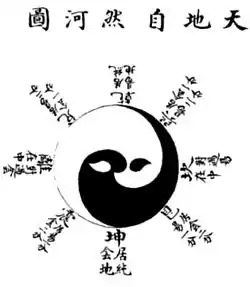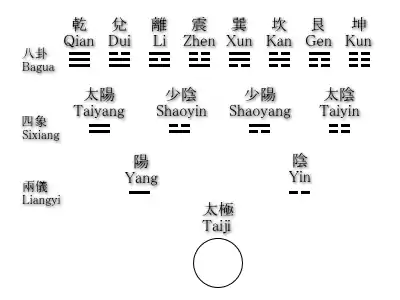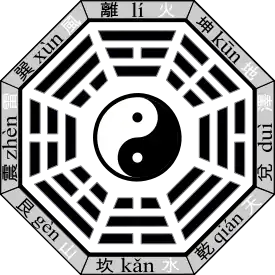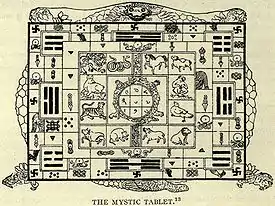Bagua
The bagua Chinese: 八卦; pinyin: bāguà; lit. 'eight trigrams' are a set of symbols indigenous to China, intended to illustrate the fundamental nature of reality as being composed of numerous mutually opposing forces reinforcing one another. bagua are trigrams—composed of three lines, each either "broken" or "unbroken", which in turn represent yin and yang, respectively.[1] Each line having two possible states allows for a total of 2 × 2 × 2 = 8 trigrams, whose early enumeration and characterization in China has had an outsized effect on the history of Chinese philosophy and cosmology.

| Bagua | |||||||||||||
|---|---|---|---|---|---|---|---|---|---|---|---|---|---|
| Chinese name | |||||||||||||
| Chinese | 八卦 | ||||||||||||
| Literal meaning | Eight symbols | ||||||||||||
| |||||||||||||
| Vietnamese name | |||||||||||||
| Vietnamese alphabet | Bát quái | ||||||||||||
| Chữ Hán | 八卦 | ||||||||||||
| Korean name | |||||||||||||
| Hangul | 팔괘 | ||||||||||||
| Hanja | 八卦 | ||||||||||||
| Japanese name | |||||||||||||
| Kanji | 八卦 | ||||||||||||
| Hiragana | はっけ | ||||||||||||
| |||||||||||||
The trigrams are related to the divination practice as described within the I Ching and practiced as part of the Shang and Zhou state religion—as well as with the concepts of taiji and the five elements within traditional Chinese metaphysics.[2] The trigrams have correspondences in astronomy, divination, meditation, astrology, geography, geomancy (fengshui), anatomy, decorative arts, the family, martial arts (particularly taijiquan and baguazhang), Chinese medicine and elsewhere.[3][4]
The bagua can appear singly or in combination, and are commonly encountered in two different arrangements: the Primordial (先天八卦), "Earlier Heaven",[5] or "Fu Xi" bagua (伏羲八卦) and the Manifested (後天八卦), "Later Heaven",[5] or "King Wen" bagua.
In the I Ching, two trigrams are stacked together to create a six-line figure known as a hexagram. There are 64 possible permutations. The 64 hexagrams and their descriptions make up the book. The trigram symbolism can be used to interpret the hexagram figure and text. An example from Hexagram 19 commentary: "The earth above the lake: The image of Approach. Thus the superior man is inexhaustible in his will to teach, and without limits in his tolerance and protection of the people."[6] The trigrams have been used to organize Yijing charts as seen below.
Trigrams
There are eight possible combinations to render the various trigrams:
| Trigram figure | Possible binary value[7] | Possible decimal sequential number[7] | Name | Translation: Wilhelm[8] | Image in nature (pp.l-li) | Phase[9] | Later Heaven's Direction (p. 269)[9] | Later Heaven's Equinox or Solstice[9] | Earlier Heaven's Direction[9] | Earlier Heaven's Equinox or Solstice[9] | Family relationship (p. 274) | Body part (p. 274) | Attribute (p. 273) | Stage/ state (pp.l-li) | Animal (p. 273) | Obtained Images[10] | |
|---|---|---|---|---|---|---|---|---|---|---|---|---|---|---|---|---|---|
| 1 | ☰ | 111 | 7 | 乾 qián | the Creative, '(natural) force' | heaven, sky 天 | metal | northwest | south | Summer Solstice | father | head | strong, persisting | creative | 馬 horse | 三連 three lines | |
| 2 | ☱ | 110 | 6 | 兌 duì | the Joyous, 'open (reflection)' | lake, marsh 澤 | metal | west | Fall Equinox | southeast | third daughter | mouth | pleasure | tranquil (complete devotion) | 羊 sheep, goat | 上缺 flawed above | |
| 3 | ☲ | 101 | 5 | 離 lí | the Clinging, 'radiance' | fire, glow 火 | fire | south | Summer Solstice | east | Spring Equinox | second daughter | eye | light-giving, humane "dependence" | clinging, clarity, adaptable | 雉 pheasant | 中虛 hollow middle |
| 4 | ☳ | 100 | 4 | 震 zhèn | the Arousing, 'shake' | thunder 雷 | wood | east | Spring Equinox | northeast | first son | foot | inciting movement | initiative | 龍 dragon | 仰盂 face-up jar | |
| 5 | ☴ | 011 | 3 | 巽 xùn | the Gentle, 'ground' | wind, air 風 | wood | southeast | southwest | first daughter | thigh | penetrating | gentle entrance | 雞 fowl | 下斷 broken below | ||
| 6 | ☵ | 010 | 2 | 坎 kǎn | the Abysmal, 'gorge' | water 水 | water | north | Winter Solstice | west | Fall Equinox | second son | ear | dangerous | in-motion | 豕 pig | 中滿 full middle |
| 7 | ☶ | 001 | 1 | 艮 gèn | Keeping Still, bound | mountain 山 | earth | northeast | northwest | third son | hand | resting, stand-still | completion | 狗 dog | 覆碗 face-down bowl | ||
| 8 | ☷ | 000 | 0 | 坤 kūn | the Receptive, field | ground, earth 地 | earth | southwest | north | Winter Solstice | mother | belly | devoted, yielding | receptive | 牛 cow | 六斷 six fragments |
Relation to other principles

Book of Changes listed two sources for the eight trigrams. The chapter Xì Cí shàng; 'The Great Treatise I' explains the first source thus:[12][13]
易有太極,
是生兩儀,
兩儀生四象,
四象生八卦,Yì yǒu tàijí,
shì shēng liǎngyí,
liǎngyí shēng sìxiàng,
sìxiàng shēng bāguà,In Change there is the Supreme Polarity,
which generates the Two Modes. (兩儀; Liangyi)
The Two Modes generate the Four Images, (sixiang)
and the Four Images generate the Eight Trigrams.
This explanation would later be modified to:[9]
The Limitless (Wuji) produces the delimited, and this is the Absolute (Taiji). The Taiji produces two forms, named Yin and Yang.[lower-alpha 1] The two forms produce four phenomena, named lesser yang, great yang (tai yang also means the Sun), lesser yin, great yin (tai yin also means the Moon). The four phenomena act on the eight trigrams (ba gua), eight eights are sixty-four hexagrams
Another chapter, 說卦; Shuō Guà; 'Discussing the Trigrams', characterizes the 乾; Qián trigram, which represents Heaven, and 坤; Kūn, which represent earth, as father and mother, respectively, of the six other trigrams, who are their three sons (震; Zhèn, 坎; Kǎn, 艮; Gèn) and three daughters (巽; Xùn, 離; Lí, 兌; Duì).[16]
The trigrams are related to the five elements of Wu Xing, used by feng shui practitioners and in traditional Chinese medicine. Those five elements are Water, Wood, Fire, Earth and Metal. The Water and Fire trigrams correspond directly with the Water and Fire elements. The element of Earth corresponds with both the trigrams of Earth and Mountain. The element of Wood corresponds with the trigrams of Wind (as a gentle but inexorable force that can erode and penetrate stone) and Thunder. The element of Metal corresponds with the trigrams of Heaven and Lake.[16][9]
Hexagram lookup table
Upper Lower |
☰ | ☱ | ☲ | ☳ | ☴ | ☵ | ☶ | ☷ |
|---|---|---|---|---|---|---|---|---|
| 乾 | 兌 | 離 | 震 | 巽 | 坎 | 艮 | 坤 | |
| Heaven | Lake | Flame | Thunder | Wind | Water | Mountain | Earth | |
| ☰ | 1 | 43 | 14 | 34 | 9 | 5 | 26 | 11 |
| ䷀ | ䷪ | ䷍ | ䷡ | ䷈ | ䷄ | ䷙ | ䷊ | |
| 乾 | 乾 | 夬 | 大有 | 大壯 | 小畜 | 需 | 大畜 | 泰 |
| Heaven | Force | Displacement | Great Possessing | Great Invigorating | Small Harvest | Attending | Great Accumulating | Pervading |
| ☱ | 10 | 58 | 38 | 54 | 61 | 60 | 41 | 19 |
| ䷉ | ䷹ | ䷥ | ䷵ | ䷼ | ䷻ | ䷨ | ䷒ | |
| 兌 | 履 | 兌 | 睽 | 歸妹 | 中孚 | 節 | 損 | 臨 |
| Lake | Treading | Open | Polarising | Converting the Maiden | Inner Truth | Articulating | Diminishing | Nearing |
| ☲ | 13 | 49 | 30 | 55 | 37 | 63 | 22 | 36 |
| ䷌ | ䷰ | ䷝ | ䷶ | ䷤ | ䷾ | ䷕ | ䷣ | |
| 離 | 同人 | 革 | 離 | 豐 | 家人 | 既濟 | 賁 | 明夷 |
| Flame | Concording People | Skinning | Radiance | Abounding | Dwelling People | Already Fording | Adorning | Intelligence Hidden |
| ☳ | 25 | 17 | 21 | 51 | 42 | 3 | 27 | 24 |
| ䷘ | ䷐ | ䷔ | ䷲ | ䷩ | ䷂ | ䷚ | ䷗ | |
| 震 | 無妄 | 隨 | 噬嗑 | 震 | 益 | 屯 | 頤 | 復 |
| Thunder | Innocence | Following | Gnawing Bite | Shake | Augmenting | Sprouting | Swallowing | Returning |
| ☴ | 44 | 28 | 50 | 32 | 57 | 48 | 18 | 46 |
| ䷫ | ䷛ | ䷱ | ䷟ | ䷸ | ䷯ | ䷑ | ䷭ | |
| 巽 | 姤 | 大過 | 鼎 | 恆 | 巽 | 井 | 蠱 | 升 |
| Wind | Coupling | Great Exceeding | Holding | Persevering | Ground | Welling | Correcting | Ascending |
| ☵ | 6 | 47 | 64 | 40 | 59 | 29 | 4 | 7 |
| ䷅ | ䷮ | ䷿ | ䷧ | ䷺ | ䷜ | ䷃ | ䷆ | |
| 坎 | 訟 | 困 | 未濟 | 解 | 渙 | 坎 | 蒙 | 師 |
| Water | Arguing | Confining | Before Completion | Deliverance | Dispersing | Gorge | Enveloping | Leading |
| ☶ | 33 | 31 | 56 | 62 | 53 | 39 | 52 | 15 |
| ䷠ | ䷞ | ䷷ | ䷽ | ䷴ | ䷦ | ䷳ | ䷎ | |
| 艮 | 遯 | 咸 | 旅 | 小過 | 漸 | 蹇 | 艮 | 謙 |
| Mountain | Retiring | Conjoining | Sojourning | Small Exceeding | Infiltrating | Limping | Bound | Humbling |
| ☷ | 12 | 45 | 35 | 16 | 20 | 8 | 23 | 2 |
| ䷋ | ䷬ | ䷢ | ䷏ | ䷓ | ䷇ | ䷖ | ䷁ | |
| 坤 | 否 | 萃 | 晉 | 豫 | 觀 | 比 | 剝 | 坤 |
| Earth | Obstruction | Clustering | Prospering | Providing-For | Viewing | Grouping | Stripping | Field |
Fu Xi's "Earlier Heaven"

| 卦名 Name |
自然 Nature |
季节 Season |
性情 Personality |
家族 Family |
方位 Direction |
意義 Meaning |
|---|---|---|---|---|---|---|
| 乾 Qián | 天 Sky (Heaven) | Summer | Creative | 父 Father | 南 South | 健 Expansive energy, the sky. For further information, see tiān. |
| 巽 Xùn | 風 Wind | Summer | Gentle | 長女 Eldest Daughter | 西南 Southwest | 入 Gentle penetration, flexibility. |
| 坎 Kǎn | 水 Water | Autumn | Abysmal | 中男 Middle Son | 西 West | 陷 Danger, rapid rivers, the abyss, the moon. |
| 艮 Gèn | 山 Mountain | Autumn | Still | 少男 Youngest Son | 西北 Northwest | 止 Stillness, immovability. |
| 坤 Kūn | 地 Earth | Winter | Receptive | 母 Mother | 北 North | 順 Receptive energy, that which yields. For further information, see dì. |
| 震 Zhèn | 雷 Thunder | Winter | Arousing | 長男 Eldest Son | 東北 Northeast | 動 Excitation, revolution, division. |
| 離 Lí | 火 Fire | Spring | Clinging | 中女 Middle Daughter | 東 East | 麗 Rapid movement, radiance, the sun. |
| 兌 Duì | 澤 Lake | Spring | Joyous | 少女 Youngest Daughter | 東南 Southeast | 悅 Joy, satisfaction, stagnation. |
King Wen's "Later Heaven"

| 卦名 Name |
自然 Nature |
季节 Season |
性情 Personality |
家族 Family |
方位 Direction |
意義 Meaning |
|---|---|---|---|---|---|---|
| 離 Li | 火 Fire | Summer | Clinging | 中女 Middle Daughter | 南 South | 麗 Pulsing motion, radiance, the luminaries. |
| 坤 Kun | 地 Earth | Summer | Receptive | 母 Mother | 西南 Southwest | 順 Receptive energy, that which yields. |
| 兌 Dui | 澤 Lake | Autumn | Joyous | 少女 Youngest Daughter | 西 West | 悅 Joy, satisfaction, stagnation. |
| 乾 Qian | 天 Heaven | Autumn | Creative | 父 Father | 西北 Northwest | 健 Expansive energy, the sky. |
| 坎 Kan | 水 Water | Winter | Abysmal | 中男 Middle Son | 北 North | 陷 Danger, rapid rivers, the abyss, the moon. |
| 艮 Gen | 山 Mountain | Winter | Still | 少男 Youngest Son | 東北 Northeast | 止 Stillness, immovability. |
| 震 Zhen | 雷 Thunder | Spring | Arousing | 長男 Eldest Son | 東 East | 動 Excitation, revolution, division. |
| 巽 Xun | 風 Wind | Spring | Gentle | 長女 Eldest Daughter | 東南 Southeast | 入 Gentle penetration, flexibility. |
In feng shui
The bagua is an essential tool in the majority of feng shui schools. The bagua used in feng shui can appear in two different versions: the Earlier Heaven bagua, used for burial sites, and the Later Heaven bagua, used for the residences.
Primordial bagua
In Primordial bagua, also known as Fu Xi Bagua or Earlier Heaven Bagua, In Traditional Chinese medicine this sequence is known as prenatal sequence and is used to understand familial disposition to illness or disease, similar to western medicine's understanding of formative medicine and the study of genetics. The Heaven is in the higher part and the Earth is in the lower part. The Heaven trigram is at the top, the Earth trigram is at the bottom (the South was located at the top in Chinese maps of this period). The Fire trigram is located on the left, and opposite to it is the Water trigram. Thunder and wind form another pair, while being one opposite the other, the first on the bottom left next to fire, while the second is next to Heaven on the top right of the bagua. Mountain and Lake form the last pair, one opposite the other, both in balance and harmony. The adjustment of the trigrams is symmetrical by forming exact contrary pairs. They symbolize the opposite forces of Yin and Yang and represent an ideal state, when everything is in balance.
Later Heaven bagua
The sequence of trigrams in the Later Heaven bagua is attributed to King Wen, also known as the postnatal bagua arrangement in Traditional Chinese medicine that is used to understand physical, emotional and environmental patterns that influences health or disease similar to western medicine's inquiry into functional medical science.[17] In this arrangement Water is placed downwards and Fire at the top, Thunder in the East and Lake in the West. Contrary to the Earlier Heaven bagua, this one is a dynamic bagua where energies and the aspects of each trigram flow towards the following. It is the sequence used by the Luo Pan compass which is used in feng shui and referred to as the manifest pattern analyzes the movement of the qi that practitioners believe affect them.
Western bagua
Feng shui was made very popular in the West thanks to the bagua of the eight aspirations. Each trigram corresponds to an aspect of life which, in its turn, corresponds to one of the cardinal directions. Applying feng shui using the bagua of the eight aspirations (or bagua map for short) made it possible to simplify feng shui and to bring it within the reach of everyone. Western bagua focuses more heavily on the power of intention than the traditional forms of feng shui.[18]
Masters of traditional feng shui disregard this approach,[19] for its simplicity, because it does not take into account the forms of the landscape or the temporal influence or the annual cycles. The bagua of the eight aspirations is divided into two branches: the first, which uses the compass and cardinal directions, and the second, which uses the Bagua by using the main door. It is clear that, not taking into account the cardinal directions, the second is even more simplified.
Bagua map
A bagua map is a tool used in Western forms of feng shui to map a room or location and see how the different sections correspond to different aspects in one's life. These sections are believed to relate to every area or aspect of life and are divided into such categories as: fame, relationships/marriage, children/creativity, helpful people/travel, career, inner knowledge, family/ancestors/health, and wealth/blessings.
In this system, the map is intended to be used over the land, one's home, office or desk to find areas lacking good chi, and to show where there are negative or missing spaces that may need rectifying or enhancing in life or the environment.
For example, if the bagua grid is placed over the entire house plan and it shows the toilet, bathroom, laundry, or kitchen in the wealth/blessings area it would be considered that the money coming into that particular environment would disappear very fast, as if to be 'going down the drain.'

In Unicode
The bagua symbols are in the Miscellaneous Symbols block of Unicode:
| Official Name | Glyph | Unicode # | HTML | Element |
|---|---|---|---|---|
| Trigram for Heaven | ☰ | U+2630 | ☰ | Metal |
| Trigram for Lake | ☱ | U+2631 | ☱ | |
| Trigram for Fire | ☲ | U+2632 | ☲ | Fire |
| Trigram for Thunder | ☳ | U+2633 | ☳ | Wood |
| Trigram for Wind | ☴ | U+2634 | ☴ | |
| Trigram for Water | ☵ | U+2635 | ☵ | Water |
| Trigram for Mountain | ☶ | U+2636 | ☶ | Earth |
| Trigram for Earth | ☷ | U+2637 | ☷ |
The constituent ⚋ yin and ⚊ yang bars that form them are also encoded in the Miscellaneous Symbols block, as are the digrams ⚌, ⚏, ⚍, and ⚎.
The hexagrams they form are separately encoded as the Yijing Hexagram Symbols Unicode block.
Tools
A LaTeX package TikZ-Bagua can be used to draw the symbols.
In culture
In traditional Chinese medicine including the profession of acupuncture The principles of Bagua are called the prenatal or early heaven arrangements and the postnatal, later heaven arrangements are used for diagnosis to understand the pathogenesis of disease and illness, to select treatment plans specifically related and tailored to the patients constitution.
In Peking Opera, a role that has Daoist technique or military strategy wears a costume decorated with Taiji and Bagua.
Baguazhang and taijiquan are two Chinese martial arts based on principles derived from bagua.
The principles of Bagua are used in a form of traditional acupuncture where the prenatal, early heaven arrangements and the postnatal, later heaven arrangements are used to select points specifically related or tailored to the patients constitution to treat illness or disease.
The 2004 Philippine horror film Feng Shui and its 2014 sequel, Feng Shui 2, revolves around a cursed bagua mirror that kills those who stare into it.
Other adoptions
- Singapore dollar: the one dollar coin is shaped like a bagua.
- Flag of South Korea: a flag that has four cardinal trigrams (qian, kun, kan, li) surrounding the taegeuk, the taiji or yin-yang symbol.
- Flag of South Vietnam: the three stripes is said as a trigram representing "south".
- Tekes County and Zhuge Village: both these communities has a layout based on bagua.
See also
- Tian gan and Di zhi: the archaic calendar system of East Asia.
- Ba Xian, Eight Taoist Immortals
- Ba Mai
- Ba Duan Jin
- Chinese ritual mastery traditions
- Chinese spiritual world concepts
- Fuji (planchette writing)
- Fulu
- Greenberger–Horne–Zeilinger state
- Octal
Note
- Compare this statement from Zhou Dunyi's 太極圖說 Taijitu shuo "Explanation of the Supreme Polarity Diagram" : 「自無極而為太極。太極動而生陽,動極而靜,靜而生陰,靜極復動。一動一靜,互為其根;分陰分陽},兩儀立焉。」 (Adler's 2012 translation: "Non-polar and yet Supreme Polarity (無極而極)! The Supreme Polarity in activity generates yang 陽; yet at the limit of activity it is still. In stillness it generates yin 陰; yet at the limit of stillness it is also active. Activity and stillness alternate; each is the basis of the other. In distinguishing yin and yang, the Two Modes are thereby established.")[14][15]
References
- The World Book Encyclopedia. Vol. 19. Chicago: Scott Fetzer Company. 2003. p. 36. ISBN 0-7166-0103-6. OCLC 50204221.
- CHEN, Xin (tr. Alex Golstein). The Illustrated Canon of Chen Family Taijiquan Archived 2016-05-03 at the Wayback Machine, INBI Matrix Pty Ltd, 2007. page 11. (accessed on Scribd.com, December 14, 2009.)
- TSUEI, Wei. Roots of Chinese culture and medicine Archived 2012-08-12 at the Wayback Machine Chinese Culture Books Co., 1989.
- ZONG, Xiao-Fan and Liscum, Gary. Chinese Medical Palmistry: Your Health in Your Hand, Blue Poppy Press, 1999.
- Wilhelm, Richard (1950). The I Ching or Book of Changes. translated by Cary F. Baynes, foreword by C. G. Jung, preface to 3rd ed. by Hellmut Wilhelm (1967). Princeton, NJ: Princeton University Press. pp. 266, 269. ISBN 0-691-09750-X.
- Wilhelm, Richard (1950). I Ching. Princeton, NJ: Princeton University Press. p. 79.. The quote is from the "Image" commentary, which is one of the Ten Wings, part of the Yijing.
- "Understanding Bagua sequence" (December 6, 2015) Shanghai Daily. Quote: "According to the authentic rules of binary method, the value conversion is bottom-up. The ID numbers of Mountain (☶, 100) and Thunder (☳, 001) should be reversed, [i.e. Mountain (☶)'s binary value should be 001 while Thunder (☳)'s binary value should be 100] [...] their sequential numbers are 0-Earth, 1-Mountain, 2-Water, 3-Wind, 4-Thunder, 5-Fire, 6-Valley, and 7-Sky."
- Wilhelm, R. & Baynes, C., (1967): "The I Ching or Book of Changes", With foreword by Carl Jung, Introduction, Bollingen Series XIX, Princeton University Press, (1st ed. 1950)
- Bagua in nationsonline.org
- Zhouyi Jie (Explaining the Zhou's [Book of] Changes) "Bagua Quxiang Ge (Song about how the Eight Trigrams Obtained Their Images)" quote:《八卦取象歌》「☰乾三連,☷坤六斷,☳震仰盂,☶艮覆碗,☲離中虛,☵坎中滿,☱兌上缺,☴巽下斷。」
- "Understanding Bagua sequence" (December 6, 2015) Shanghai Daily. Quote: "Leibniz came up with the ID number of each 3-yao gua's based on the position of yao from top down to base. He defined yang yao (whole line) as 1 and yin yao (broken line) as 0. Here are some examples according to Leibniz-Shao Yong approach. Mountain (☶) can be converted to 100. [...]"
- Book of Changes "繫辭上 - Xi Ci I (The Great Treatise) 11.3" with James Legge's translation
- Zhu Xi (2020). The Original Meaning of the Yijing: Commentary on the Scripture of Change. Translated by Joseph A. Adler. New York: Columbia University Press. p. 46.
- Zhou Dunyi, Taijitu shuo. text at wikisource
- Adler, Joseph A. (2012) "On Translating Taiji 太極" in David Jones and He Jinli, eds., Rethinking Zhu Xi: Emerging Patterns Within the Supreme Polarity. Albany: SUNY Press
- Yi Jing "Shuo Gua 10". Translated by James Legge
- Golding, Roisin (2010). The Complete Stems and Branches: Time and Space in Traditional Acupuncture. Churchill Livingstone. ISBN 978-0-7020-2961-5.
- Cisek, Jan. Feng Shui London blog, 2007.
- Moran, Elizabeth and Master Yu, Joseph. The Complete Idiot's Guide to Feng Shui, 3rd Edition, Penguin, 2005.
